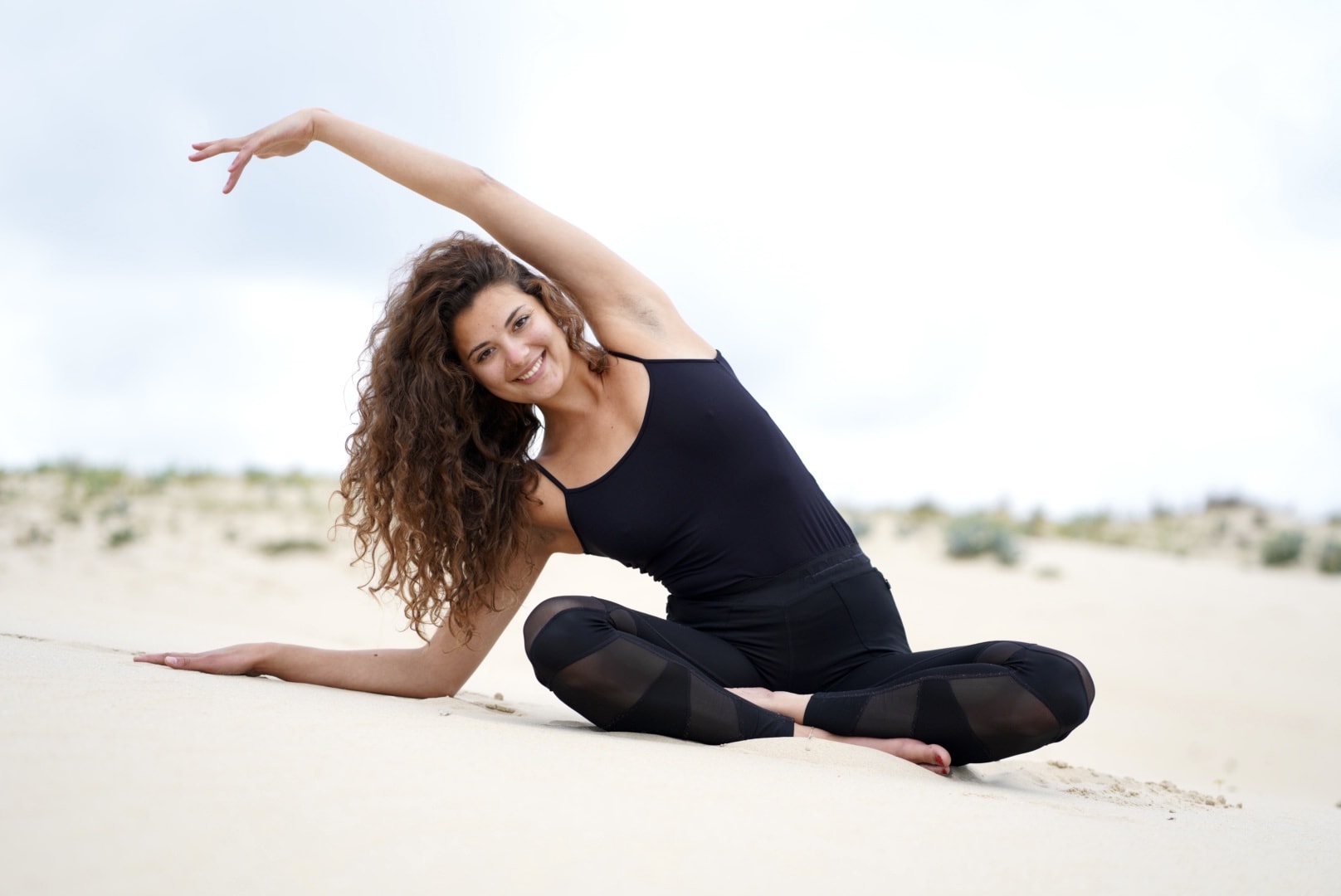
Inner balance and inner peace are a prerequisite for the goal of the yoga of
Self-realization (see chapter 3.1). Sutras 1-16 in Patanjali's Yogasutra deal with
first of all about what yoga is (1-4). In sutras 5-11 he deals with the mental patterns (vrittis) and in sutras 12-16 with the practice of letting go. He also describes the inner calmness of consciousness (chitta) that is necessary for the path of yoga and how to achieve it (see Skuban 2011, p. 19 ff.). The second sutra directly describes the goal and the path of yoga at the same time with: "yogash chitta-vritti-nirodhah" (Skuban 2011, p. 304), which translates as: "Yoga is the coming to rest of the constantly changing mental patterns" (Skuban 2011, p. 19). When the seer (the person) rests in himself, this is self-realization (3rd sutra) (cf. ibid., p. 20). If self-realization is not present, "the seer takes the form of mental patterns: It seems as if he is identical with them" (Skuban 2011, p. 20). According to Patanjali, this identification with thoughts and feelings that arise and pass within us is the main cause of anxiety, worry, anger and rage, in short, of all the suffering we experience (cf. ibid., p. 20 f.). In order to avoid or change this attachment, false identification (because according to Patanjali, we are more than our thoughts and feelings) and dependency on external circumstances, yoga offers the path to detachment (vairagya) in the form of practice/exercise methods (abhyasa) of the eight-limbed yoga path (see chapter 3.1, see ibid., p. 30 ff., see Schwalbach 2016, p. 18). The path to inner peace and inner freedom in yoga means "not clinging to the things we like or dislike" (Skuban 2011, p. 31) and "is an escape from the captivity of external circumstances" (Skuban 2011, p. 31). Detachment (vairagya) is also about freeing oneself (mentally) from external circumstances, which in today's world also includes circumstances that can cause stress in the modern, constantly changing meritocracy (see Schwalbach 2016, p. 18 ff.). According to yoga philosophy, yoga practice should therefore theoretically create detachment (from one's own thoughts, feelings and external circumstances) and thus prevent suffering (e.g. anxiety) and enable inner peace and inner balance. It is precisely this state of inner peace and inner balance that is considered a helpful prerequisite for being able to have sustainable learning experiences (see chapter 2.4).
In practice, this balancing effect of yoga has now been investigated in many different scientific studies and the calming and relaxing effect of yoga on the mind and body (which leads to less stress and anxiety) has been proven several times (see Broad 2013, p.125 ff.). The stress level of people can be measured, among other things, by the wear and tear of their telomeres and scientific research in recent decades (especially by Elizabeth Blackburn, who received the Nobel Prize for her research findings on telomerase) has been able to gain astonishing insights into the effect of yoga on stress and the wear and tear of telomeres (cf. ibid., p. 80 ff., cf. Abrams/ Lama/ Tutu 2019, p. 113 ff.).
Telomeres are DNA segments at the end of chromosomes and become shorter with each cell division (see Broad 2013, p. 80 ff.). This is why the telomerase level can also act as a biological clock (cf. ibid.). However, science has discovered that telomeres shorten more slowly in some people than in others and that these people therefore remain young for longer from a biological point of view (cf. ibid.). This is because telomeres either erode more quickly or are protected for longer as a result of lifestyle and physical health (cf. ibid.). One of the main factors for their erosion, in addition to diet and infections, is chronic mental stress (cf. ibid.). Reducing stress can slow down the wear and tear of telomeres. This is not to be underestimated insofar as a shortening of the telomere length leads to the ageing cells stopping cell division (cf. ibid.). So if the shortening of telomere length is slowed down by stress reduction, cells are better protected against ageing and disease (see Abrams/ Lama/ Tutu 2019, p. 113 ff.) Stress reduction can therefore slow down the biological clock (see Broad 2013, p. 82 ff.). Together with molecular biologist Elizabeth Blackburn, psychologist Elissa Epel discovered that not only stress but also general mental patterns have an influence on telomere attrition (see Abrams/ Lama/ Tutu 2019, p. 113 ff.). "Epel and Blackburn conclude from this that our cells "listen to our thoughts" (Abrams/ Lama/ Tutu 2019, p. 114). Dean Ornish, who trained as a doctor at Harvard, led a study together with Elizabeth Blackburn at the University of California in San Francisco, which investigated the effects of yoga on telomerase levels and other physical and psychological effects (see Broad 2013, p. 82). In the Ornish study, the values of 24 men (aged between 50 and 80) were measured before and after three months of one-hour yoga classes six days a week (cf. ibid.). The results published at the end of 2008 showed significantly lower cholesterol and blood pressure levels and a 30 percent reduction in telomerase levels (cf. ibid.). Lower values were also found for indicators of emotional stress (worrying thoughts) (cf. ibid.).Yoga can therefore reduce stress levels and also telomerase levels through its calming effect, thus slowing down the human biological clock and promoting longevity (cf. ibid., p. 80 ff.). The state of homeostasis, the inner balance that is necessary for sustainable learning, is regulated by the autonomic nervous system (see chapter 2.4). The autonomic nervous system is made up of the sympathetic nervous system (sympathetic nervous system) and the parasympathetic nervous system (parasympathetic nervous system) (cf. ibid., p. 142 ff.). The sympathetic nervous system is responsible for activating the body; it activates the body's fight or flight response, which had a life-preserving effect, especially in earlier times and in acute (life) danger (cf. ibid.). Today, our enemies are generally no longer sabre-toothed tigers, but stress and anxiety (for example, pressure to perform or fear of losing a job) also activate the body's sympathetic nervous system (see Abrams/ Lama/ Tutu 2019, p. 113 ff.). This mode inhibits digestive processes, releases hormones (such as adrenaline) and increases bodily functions that enable rapid action (fight or flight), for example by transporting blood to the muscles (see Broad, 2013, p. 142 f.). The sympathetic nervous system is therefore effectively "the body's accelerator pedal" (Broad 2013, p. 142). In contrast, the parasympathetic nervous system is the body's brake, responsible for calming the nerves and ensuring relaxation (cf. ibid.). It reduces the flow of adrenaline, promotes food intake and digestive functions as well as the body's resting functions (cf. ibid.). When both parts of the autonomic nervous system "work together, they control the general energy flow of the body, one [sympathetic nervous system] ensures consumption, the other [parasympathetic nervous system] ensures conservation" (Broad 2013, p. 142). This leads to a state of inner balance in which learning is possible (see chapter 2.4). The activation of the sympathetic nervous system "is planned by nature as a rare, short-term state. But for many people in the modern world, this reaction is permanent." (Abrams/ Lama/ Tutu 2019, p. 113). Due to the stress-inducing pressure to perform and "collective employment mania" (Trökes/ Knothe 2014, p. 229) of the modern meritocracy (see section 2.5.1), the sympathetic nervous system is often overexcited and the human autonomic nervous system is therefore out of balance (see section 2.4). In addition, the sympathetic nervous system is easily excitable and the "body, when left to its own devices, always prefers the accelerator pedal" (Broad 2013, p. 143). However, the autonomic nervous system can not only be influenced by environmental conditions, but can also be specifically controlled by conscious actions, such as certain muscle work (muscle tone) and breathing (respiration rate) (cf. ibid., p. 146). Through yoga, both sides of the autonomic nervous system (sympathetic and parasympathetic) can be consciously controlled and regulated (cf. ibid., p. 143 ff.). Depending on the yoga style, body postures in practice (asana) and selected breathing exercises (pranayama), both the sympathetic and parasympathetic nervous systems can be addressed (cf. ibid., p. 147 ff.). As a result, yoga practice can have either an activating or calming effect (cf. ibid.). Flowing, dynamic yoga styles with strong muscle engagement (such as Ashtanga yoga) and accelerated breathing have a stimulating effect on the sympathetic system, while yoga styles that emphasize static postures (such as Iyengar yoga) and slowed breathing activate the parasympathetic system (see ibid., p. 147 f.). The asana of shoulder stand, for example, acts on the parasympathetic system because, triggered by the body position (chin pressing on the upper chest area, which affects the carotid arteries), it takes on the role of a blood pressure reducer, one of the most important functions of the autonomic nervous system (cf. ibid., p. 144 ff.). With reference to the renowned yoga teacher Robin, Broad states that every yoga practice involves the conscious activation of both the sympathetic nervous system (the body's gas pedal) and the parasympathetic nervous system (the body's brake) in order to train the autonomic system (cf. ibid., p. 149). According to Robin, Broad describes the positive effect of the influence of yoga on the conscious control of the sympathetic and parasympathetic nervous system as follows: "Through the energetic flexibility thus gained, one overcomes the usual conditions of metabolic life and develops new abilities to achieve states of inner balance and harmony" (Broad 2013, p. 149). And it is precisely this state of inner balance and harmony (homeostasis) achieved through yoga that enables sustainable learning (see section 2.4). Apart from the activation of the parasympathetic nervous system, a biochemical factor is known in science that directly promotes the "calming down" of thoughts (cf. ibid., p. 293 f.). The neurotransmitter gamma-aminobutyric acid (GABA for short) has a calming effect on the body and mind (cf. ibid.). The release of GABA directly calms thoughts, as it slows down neuronal activity in the brain by putting the neurons in a less excitable state (cf. ibid.). The depressant alcohol slows down thinking by binding ethyl alcohol with neurons and thus creating a chemical environment that enhances the relaxing effect of GABA (cf. ibid.). In addition to alcohol, another possibility has been found which directly increases GABA levels without the unpleasant side effects of alcohol consumption (cf. ibid.). Practicing yoga has also been shown to increase GABA levels (up to double) and thus directly trigger a calming effect and a slowing down of thoughts (cf. ibid.). Consequently, Broad describes the result of a regular yoga practice as follows: "a feeling of becoming physically and mentally calm, of increasing relaxation and decreasing anxiety" (Broad 2013, p. 294).
Literature:
Abrams, Douglas/ Desmond, Tutu/ Lama, Dalai (2019): The book of joy. 2nd edition.
Munich
Broad, William J. (2013): The Science of Yoga. What it promises - and what it can do.
Freiburg im Breisgau
Schwalbach, Michael (2016): Yoga and meditation for managers. Introduction to
The ancient wisdom of yoga for better leadership. Wiesbaden.
Skuban, Ralph (2011): Patanjali's Yogasutra. The royal road to a wise life. 4.
Edition. Munich
Trökes, Anna/ Knothe, Bettina (2014): Neuro-Yoga. How the ancient wisdom practice
how our brain works. Munich
